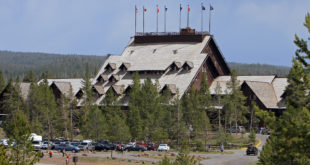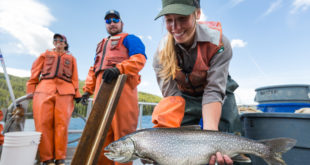| |
Yellowstone has Issues
In a way, getting to know Yellowstone National Park and its region is like meeting a person for the first time—a first impression is important but superficial. In time, if you really get to know someone, you begin to see more sides to them, both good and not so good. Yellowstone is a wonderful experience for most people most of the time. Beautiful scenery, exciting geysers, plentiful wildlife, and typically fine weather in the summer combine to make Yellowstone a great place for a vacation. People come to Yellowstone not only to see the sights, but to ‘get away from it all’ or ‘get back to nature,’ and do so successfully. It’s easy and almost natural to enjoy the park without knowing anything about park issues and controversies. However the issues are there. Some issues involve very essential things about the park—the animals, fish, water, even the scenery. Some of the controversies involve deeply felt passions for people both inside and outside the park.
Yellowstone began in controversy. In the early 1870’s the idea of setting aside a large area of land as a federal preserve to protect natural features was both novel and controversial. The Congress of the United States had fierce debates, with some saying, in effect, ‘Who cares?’ Yellowstone is far away in the wilderness, why bother spending any effort, much less money, to ‘protect’ it? Others took the position that although the natural wonders of Yellowstone were special, they would be well looked after if commercial interests were allowed to develop the area. Still others felt that the area was so unique that a unique form of protection was necessary; that it was necessary to make a national park. In the end, this last group—with a substantial push from military and railroad interests—prevailed; Yellowstone became the world’s first national park in 1872.
That did not end controversy. From the beginning there were conflicting interests. It didn’t take long to realize that although Yellowstone was ‘way out in the wilderness,’ it wasn’t going to remain wilderness for long. Settlers—ranchers and farmers—were advancing across Montana, Wyoming, and Idaho. The railroads passed by Yellowstone’s doorstep and the railroad companies wanted to bring tourists to the park. Commercial interests, along with hunters, miners, poachers, and occasional land squatters were already active throughout the area. But the park had no budget and hardly any administration. The first ten to fifteen years of the park were truly ‘wild west,’ which produced headlines of tourist robberies and outrage over the abuse of nature that echoed all the way back to Washington. As a measure of how bad things were, the United States Cavalry was sent to take control of the park in 1886 and remained until the coming of the National Park Service in 1918.
As the first, most famous, and in many ways the most diverse of the national parks, Yellowstone is a lightning rod for almost all major issues of conservation, wildlife management, and environmental protection. Few of the controversies are unique to Yellowstone, but they have special status because of the attention given to the park.
Nothing illustrates this attention better than the fires of 1988. Forest fires happen nearly every year in Yellowstone. The fires that sprung up in late June of 1988 seemed typical, but it was a drought year, one of the worst in modern times. By August the fires were still burning and getting bigger. Suddenly in mid-August, fanned by winds up to fifty miles per hour, the fires exploded. They became national news, featured by every television network. Before the end of August, the whole world was seeing daily reports on the fierce firestorms, the plight of Yellowstone’s forests, and the massive fire fighting effort. After it was all over, the Yellowstone fires of ’88 generated thousands of print articles, hours of television coverage, and eventually dozens of documentaries and books. Fighting the fires involved over 10,000 people and cost more than $120 million dollars – many times the yearly budget of the park. No wonder the fires were controversial. The fires of 1988 are still controversial: Why were they not prevented? Were they a good thing? Why did we spend so much money fighting them (in vain)? And so on…
What happens in Yellowstone matters to a lot of people.
The “A” (as in Arguments) List
At any given time there are usually about a dozen issues cooking at various levels of intensity. Here’s a thumbnail outline of the current batch:
Wolves – The re-introduction of wolves to the Yellowstone ecosystem in 1995 caused a nationwide uproar. As wolf packs spread throughout the region and attack ranch animals, the controversy is very much alive.
Forest fire management – The great fires of 1988 highlighted the fire management policies of the U.S. Forest Service and the National Park Service, making them more controversial than ever. Although it is generally agreed that ‘natural burning’ should be allowed, this is still a hot topic.
Bison and brucellosis containment – Bison that leave the park in winter are rounded up and slaughtered every year in order to prevent the spread of the disease brucellosis to domestic cattle. Every aspect of this policy is in dispute.
Snowmobiling – Ever since their introduction, private snowmobiles in Yellowstone Park have been controversial. Numerous environmental studies and many policy changes have not settled the issues.
Profiting from research – The thermal pools of Yellowstone contain thousands of unique forms of life, which within the last decade have become the focus of scientific study. Occasionally there is profit to be had from commercialization of research findings, but who should benefit—the park, the scientists, individual companies?
Mining/Drilling – The last big brouhaha over mining near the park ended in 1996 with an agreement by the federal government to buy out mining interests at Cooke City, Montana (just outside the park). However, mining and other resource extraction (especially oil) in or near the park is always a possibility.
Animal population management – How many elk and bison are appropriate for Yellowstone Park? Should greater populations be allowed to develop outside the park? Can or should the populations be managed? Even wildlife specialists don’t agree.
Grizzly bear status – Has the grizzly bear population recovered enough to remove it from the list of endangered species? This is a relatively recent controversy popular with hunters and detested by animal supporters.
Habitat shrinkage – How much land development should be allowed near Yellowstone (and other) parks? How has the loss of habitat due to development affected the animal and bird populations of the region? Regulation of development, especially for commercial and residential purposes is a very contentious topic.
Cutthroat trout status – Because of the lake trout crisis in Yellowstone Lake, should the cutthroat trout be considered an endangered species? The U.S. Forest service doesn’t think so; many sports and conservation groups think it should be.
Park infrastructure (roads and buildings) – Although much improved in the past ten years, roads and buildings in Yellowstone Park are still in need of maintenance and upgrade – if and when the money is available.
Access VS conservation – The oldest and most tenacious controversy in the park involves its dual mission: Preserve and protect the wildlife and natural features; provide access for the enjoyment of the public. What is the ‘right’ balance? The argument continues.
One last issue: All these issues are related to the entire ecosystem of the greater Yellowstone region, not just Yellowstone Park. Nature has boundaries but they are not lines drawn on a map. The boundaries change with season, climate, geologic events, and the rise or fall of species. The fact that “Greater Yellowstone” is in three states, twenty-five counties, seven national forests, two national parks (and so forth) means nothing (well, almost nothing) to the ecosystem. But it means a lot to us humans–“turf wars” is no idle concept around Yellowstone; and that’s just part of what makes the whole concept of a Greater Yellowstone Ecosystem an issue.
 Yellowstone Insider Your Complete Guide to America's First National Park
Yellowstone Insider Your Complete Guide to America's First National Park





